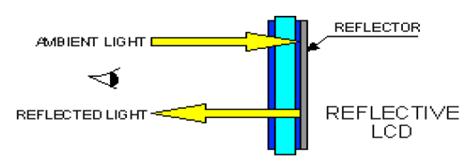LCD viewing direction and viewing mode
LCD viewing direction
The viewing direction of a LCD part is defined as the angles above ( 12:00 clock), below ( 6:00 clock), left ( 9:00 clock), and right ( 3:00 clock) of the point-of-view that is perpendicular to the center of the display, and it means that the contrast of display is the best from one of particular viewing direction.
Display viewing angle highly depends how the display device is used, 6:00 clock is necessary for the display device to be mounted on the wall where is higher than a view’s eye viewing level, and 12:00 clock is chosen for the display device to be put on the table and mounted on the wall where is lower than a viewer’s eye level.
Although the LCD’s viewing angle is set by the LCD manufacturer, the user can still tilt it to fit into one’s application.

LCD viewing modes
There are three basic viewing modes and they can be realized on by simply using different rear polarizers that are reflective type polarizer or trasflective type polarizer or transmissive polarizer.
Reflective polarizer: it includes a diffuse reflector, such as brushed aluminum. This layer reflects polarized ambient light that has entered the front of the display back trough the LCD cell.
Reflective displays require ambient light to be seen. They exhibit high brightness, excellent contrast, and wide viewing angles. They are particularly suitable for use in battery operated equipment where an adequate level of light is always available. Reflective LCD's cannot be backlit, however they can be front lighted in some applications

Transmissive polarizer has no reflector laminated on a clear transmissive polarizer.
Displays have a clear polarizer on the front and the back. The display therefore depends on light coming through from the back of the display toward the observer in order to be seen. Most but not all transmissive displays are negative image.

Transflective polarizer has a translucent reflector that allows a certain percentage of light transmitted.
Display with a transflective polarizer reflects part of the ambient light, and also transmits backlighting. As the name implies, it is a compromise between the transmissive and reflective viewing mode. Used in reflection, it is not as bright and has lower contrast than the reflective type LCD, but it can be backlit for use in low light conditions.


